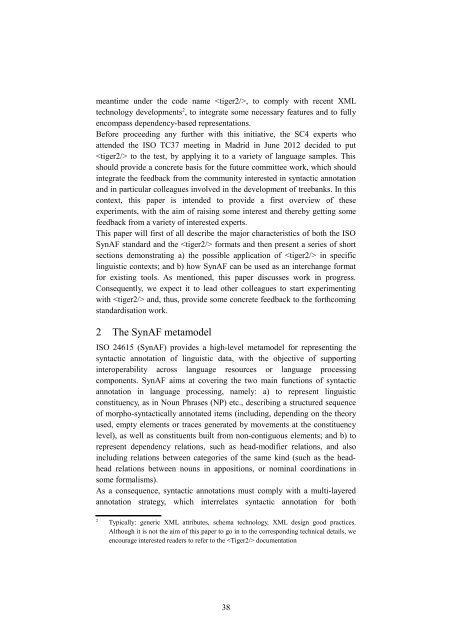A Treebank-based Investigation of IPP-triggering Verbs in Dutch
A Treebank-based Investigation of IPP-triggering Verbs in Dutch
A Treebank-based Investigation of IPP-triggering Verbs in Dutch
You also want an ePaper? Increase the reach of your titles
YUMPU automatically turns print PDFs into web optimized ePapers that Google loves.
meantime under the code name , to comply with recent XML<br />
technology developments 2 , to <strong>in</strong>tegrate some necessary features and to fully<br />
encompass dependency-<strong>based</strong> representations.<br />
Before proceed<strong>in</strong>g any further with this <strong>in</strong>itiative, the SC4 experts who<br />
attended the ISO TC37 meet<strong>in</strong>g <strong>in</strong> Madrid <strong>in</strong> June 2012 decided to put<br />
to the test, by apply<strong>in</strong>g it to a variety <strong>of</strong> language samples. This<br />
should provide a concrete basis for the future committee work, which should<br />
<strong>in</strong>tegrate the feedback from the community <strong>in</strong>terested <strong>in</strong> syntactic annotation<br />
and <strong>in</strong> particular colleagues <strong>in</strong>volved <strong>in</strong> the development <strong>of</strong> treebanks. In this<br />
context, this paper is <strong>in</strong>tended to provide a first overview <strong>of</strong> these<br />
experiments, with the aim <strong>of</strong> rais<strong>in</strong>g some <strong>in</strong>terest and thereby gett<strong>in</strong>g some<br />
feedback from a variety <strong>of</strong> <strong>in</strong>terested experts.<br />
This paper will first <strong>of</strong> all describe the major characteristics <strong>of</strong> both the ISO<br />
SynAF standard and the formats and then present a series <strong>of</strong> short<br />
sections demonstrat<strong>in</strong>g a) the possible application <strong>of</strong> <strong>in</strong> specific<br />
l<strong>in</strong>guistic contexts; and b) how SynAF can be used as an <strong>in</strong>terchange format<br />
for exist<strong>in</strong>g tools. As mentioned, this paper discusses work <strong>in</strong> progress.<br />
Consequently, we expect it to lead other colleagues to start experiment<strong>in</strong>g<br />
with and, thus, provide some concrete feedback to the forthcom<strong>in</strong>g<br />
standardisation work.<br />
2 The SynAF metamodel<br />
ISO 24615 (SynAF) provides a high-level metamodel for represent<strong>in</strong>g the<br />
syntactic annotation <strong>of</strong> l<strong>in</strong>guistic data, with the objective <strong>of</strong> support<strong>in</strong>g<br />
<strong>in</strong>teroperability across language resources or language process<strong>in</strong>g<br />
components. SynAF aims at cover<strong>in</strong>g the two ma<strong>in</strong> functions <strong>of</strong> syntactic<br />
annotation <strong>in</strong> language process<strong>in</strong>g, namely: a) to represent l<strong>in</strong>guistic<br />
constituency, as <strong>in</strong> Noun Phrases (NP) etc., describ<strong>in</strong>g a structured sequence<br />
<strong>of</strong> morpho-syntactically annotated items (<strong>in</strong>clud<strong>in</strong>g, depend<strong>in</strong>g on the theory<br />
used, empty elements or traces generated by movements at the constituency<br />
level), as well as constituents built from non-contiguous elements; and b) to<br />
represent dependency relations, such as head-modifier relations, and also<br />
<strong>in</strong>clud<strong>in</strong>g relations between categories <strong>of</strong> the same k<strong>in</strong>d (such as the headhead<br />
relations between nouns <strong>in</strong> appositions, or nom<strong>in</strong>al coord<strong>in</strong>ations <strong>in</strong><br />
some formalisms).<br />
As a consequence, syntactic annotations must comply with a multi-layered<br />
annotation strategy, which <strong>in</strong>terrelates syntactic annotation for both<br />
2<br />
Typically: generic XML attributes, schema technology, XML design good practices.<br />
Although it is not the aim <strong>of</strong> this paper to go <strong>in</strong> to the correspond<strong>in</strong>g technical details, we<br />
encourage <strong>in</strong>terested readers to refer to the documentation<br />
38
















